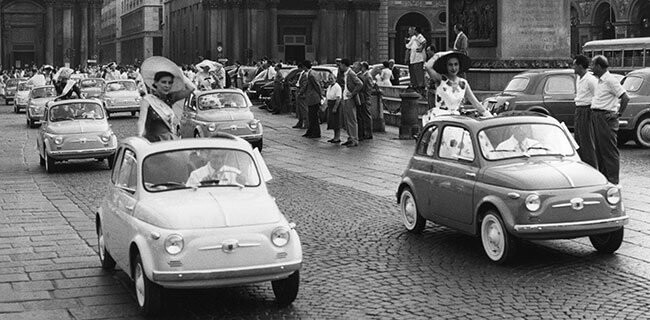Icon 500

The Classic Fiat 500 is one of the most iconic symbols of Italian automotive history, a representation of an era, a culture, and a design that defined an entire generation. Here's the story of the Fiat 500, a small car that changed mobility in Italy and around the world.
The Birth of the Fiat 500: 1957
The Fiat 500 was unveiled in July 1957. With its full name Fiat Nuova 500, the car was conceived as an affordable vehicle designed to meet the mobility needs of post-war Italy. Fiat, aware of the need for a compact, economical, and functional car, designed the 500 as a two-seater that could be accessible to everyone.
The Design: A Car for Everyone
The Fiat 500 was designed by Dante Giacosa, an engineer and designer who had already worked on numerous automotive projects for Fiat. The design featured simple, rounded lines, with a body seemingly made to optimize limited space. The 500 measured only 2.97 meters in length and 1.32 meters in width, making it perfect for the narrow streets of Italian cities.
The Engine and Technical Features
The Fiat 500 was equipped with a two-cylinder, four-stroke engine of 479 cc, capable of producing 13 horsepower. The car reached a top speed of about 85 km/h and had extremely low fuel consumption—a key factor in its success. It featured a 4-speed manual transmission and small tires, which made it very easy to handle.
Evolution Over Time: Fiat 500 "D"
In 1957, Fiat launched the original version of the 500, but in 1959 a new and improved version was introduced: the Fiat 500 D. The "D" version (named after its modified engine type) brought several important changes compared to the previous model. The engine was upgraded, a new cooling system was introduced, and the exterior design was made even more refined. Additionally, the Fiat 500 D featured a body with a retractable roof, which became one of the signature features of this version.
The 500 as a Symbol of an Era
The Fiat 500 quickly became a symbol of Italy’s post-war economic growth. Its simple design, low price, and practicality made it the ideal car for many Italian families. It also gained popularity abroad thanks to its versatility and international appeal, especially among younger generations.
During the 1960s, the Fiat 500 continued to evolve, but it always stayed true to its nature as a small, economical car. In the 1970s and 1980s, production was discontinued, but the 500 remained in the hearts of many Italians.
During the 1960s, the Fiat 500 continued to evolve, but it always stayed true to its nature as a small, economical car. In the 1970s and 1980s, production was discontinued, but the 500 remained in the hearts of many Italians.
The Sunset and the Revival
Production of the original Fiat 500 ended in 1975, but its legacy never died. In 2007, Fiat decided to revive the legend of the 500 with a new version that preserved the lines and spirit of the original model, while adapting to modern times. The classic Fiat 500 remains one of the most beloved cars, with many examples still being restored and collected today.
Conclusions
The Fiat 500 has become a legend—not just in Italy, but across the world. It changed the way people viewed cars: not just as a means of transport, but as a symbol of freedom, innovation, and practicality. The classic Fiat 500 D is one of the versions that made history, a small but mighty car that continues to live in the hearts of those who experienced it and those who still admire it today.


